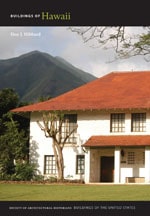Set back from W. Main Street, screened by trees and other landscaping, the Alexander house is a pleasing example of New England architecture adapted to Hawaii's climate. A high-pitched, sweeping gable roof flows down to shelter the house and its wraparound porch. This tropical ambiance is offset by a pair of narrow dormers, which punctuate the roof, and the symmetrical facade with a centered doorway that is flanked by three narrow double-hung windows. A shed-roofed balcony appears as an afterthought, poorly integrated into the design of the east gable.
This missionary house has witnessed several building stages. The Reverend Richard Armstrong initially oversaw the construction of a single-story house to shelter his family in 1836. It had ten-foot-high stone walls, twenty inches thick, and a roof thatched with ti leaves. Armstrong's son, Samuel Chapman Armstrong, was born in this house and later distinguished himself as a Civil War general and founder of the Hampton Institute, the first vocational school for African Americans in the United States. When developing Hampton, General Armstrong used such missionary schools as Lahainaluna and Hilo Boarding School as his model.
Following the departure of the Armstrongs from Wailuku, the Reverend Ephraim Clark added the second-story gable roof in 1843. In 1856, missionary William Alexander and his family moved into the house and resided here until Reverend Alexander's death in 1884. In 1905, Mrs. Henry Perrine Baldwin, the former Emily Alexander, acquired the house, and in 1919 donated it to the Maui Aid Association. For many years it served as the parsonage for the Wailuku Union Church (MA14) until it was converted into offce space in the early 1990s. The small board-and-batten building situated below the main house was built in 1912 as an offce for the Maui Aid Association. Founded in 1909, the association's primary purpose was to render “aid and assistance to churches and religious institutions associated with the Board of the Hawaiian Evangelical Association.” To this end, it handled all matters relating to the construction and repair of member church buildings on Maui.


